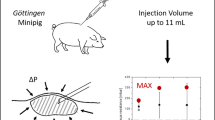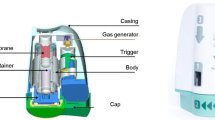Abstract
Purpose
For a novel needle-free injection (NFI) system, the relationship between frequency of wet or incomplete injections and device-related factors and subject physiological variables was examined.
Materials and Methods
A total of 26 device configurations of a single-use pre-filled NFI system (Intraject®) were used to deliver a total of 3,211 subcutaneous injections into the abdomen of 302 healthy volunteers. Two validated methods were used to determine completeness of each injection (defined as ≥90% dose delivery). Skin-fold thickness, body mass index (BMI), Fitzpatrick skin type, sex, age, and injection site were noted for each volunteer.
Results
The proportion of complete injections ranged from 59–98% among the various combinations of device configurations. Two device parameters and two subject-related variables showed strong association with injection performance; Device gas mass (chamber pressure) and orifice size demonstrated statistically significant, independent effects, with increasing gas mass and larger orifice size associated with improved injection performance. BMI and site of injection on the abdomen also demonstrated statistically significant effects with increasing BMI and lateral rather than medial injection sites associated with better injections.
Conclusion
Both device-related factors and subject variables interact to mediate in vivo performance of a needle-free injector.






Similar content being viewed by others
Notes
Data on file at Zogenix Inc.
References
R. A. Hingson, H. S. Davis, and M. Rosen. The historical development of jet injection and envisioned uses in mass immunization and mass therapy based upon two decades’ experience. Mil. Med. 128:516–524 (1963).
R. A. Hingson, H. S. Davis, and M. Rosen. Clinical experience with one and a half million jet injections in parenteral therapy and in preventive medicine. Mil. Med. 128:525–528 (1963).
F. H. J. Figge and D. J. Barnett. Anatomic evaluation of a jet injection instrument designed to minimize pain and inconvenience of parenteral therapy. Am. Pract. 3:197–206 (1948).
E. K. Zsigmond. Jet anesthesia and jet local anesthesia for the 21st century. J. Natl. Med. Assoc. 94:1004–1006 (2002).
F. Béclard. Présentation de l’injecteur de Galante, Séance du 18 décembre 1866, Présidence de M. Bouchardat. Bulletin de l’Académie Impériale de Médecine 32:321–327 (1866).
M. Lockhart. US Patent No. 69,199 (1936).
T. King. Needle-free drug delivery. In J. Swarbrick and J. C. Boylan (eds.), Encyclopedia of Pharmaceutical Technology, 2nd Edition Taylor & Francis, New York, 2004, pp. 1–12.
J. Schramm and S. Mitragotri. Transdermal drug delivery by jet injectors: energetics of jet formation and penetration. Pharm. Res. 19:1673–1679 (2002).
J. M. Pereira, J. M. Mansour, and B. R. Davis. The effects of layer properties on shear disturbance propagation in skin. J. Biomech. Eng. 113:30–35 (1991).
J. M. Pereira, J. M. Mansour, and B. R. Davis. Analysis of shear wave propagation in skin; application to an experimental procedure. J. Biomech. 23:745–751 (1990).
M. Mridha, S. Ödman, and P. Ä. Öberg. Mechanical pulse wave propagation in gel, normal and oedematous tissues. J. Biomech. 25:1213–1218 (1992).
J. F. M. Manschot and A. J. M. Brakkee. The measurement and modelling of the mechanical properties of human skin in vivo—I. The measurement. J. Biomech. 19:511–515 (1986).
R. H. Wildnauer, J. W. Bothwell, and A. B. Douglass. Stratum corneum biomechanical properties. I. Influence of relative humidity on normal and extracted human strateum corneum. J. Invest. Derm. 56:72–78 (1971).
E. Berardesca and H. I. Maibach. Is skin color expression of racial differences in skin function? (http://www.ulb.ac.be/medecine/loce/espcr/b_iss/Dis-9b.htm).
O. A. Shergold. The mechanics of needle-free injection. PhD thesis. Cambridge University (2004).
J. Schramm-Baxter and S. Mitragotri. Needle-free jet injections: dependence of jet penetration and dispersion in the skin on jet power. J. Contr. Rel. 97:527–535 (2004).
L. H. Jansen and P. B. Rottier. Comparison of the mechanical properties of strips of human abdominal skin excised from below and above the umbilicus. Dermatologica 117:252–258 (1958).
J. Baxter and S. Mitragotri. Jet-induced skin puncture and its impact on needle-free jet injections: experimental studies and a predictive model. J. Contr. Rel. 106:361–373 (2005).
Author information
Authors and Affiliations
Corresponding author
Rights and permissions
About this article
Cite this article
Linn, L., Boyd, B., Iontchev, H. et al. The Effects of System Parameters on In Vivo Injection Performance of a Needle-Free Injector in Human Volunteers. Pharm Res 24, 1501–1507 (2007). https://doi.org/10.1007/s11095-007-9268-6
Received:
Accepted:
Published:
Issue Date:
DOI: https://doi.org/10.1007/s11095-007-9268-6




